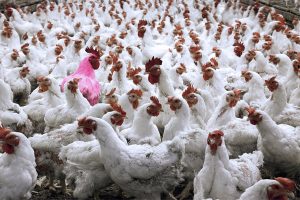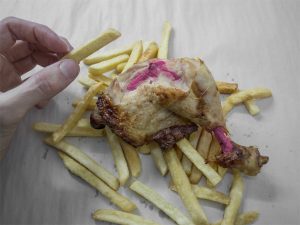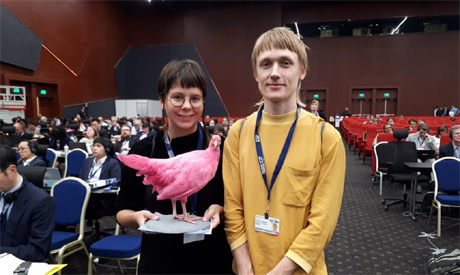Ayat Al-Tawy – Ahram Online
Two Swedish biodesigners came all the way to Egypt carrying a stuffed pink chicken this month, to shed light on new gene-editing technologies and their potential impact on the world.
Linnea Våglund and Leo Fidjeland, both 28, are spearheading a project promoting debate and reflection on how the so-called “gene drive” technologies may be used, or misused.
They propose that by genetically modifying one domestic chicken to have pink bones and feathers, they could permanently alter the entire species in just 12-19 generations, resulting in billions of pink chickens.
Gene drive technologies modify DNA, causing genetic changes, but unlike previous kinds of gene editing, the inheritability of the changes is enhanced, meaning that they spread quickly through the species, and could mean it is permanently changed.
The powerful technologies involved have been a source of controversy, with particular concern about whether releasing genetically engineered organisms could alter ecosystems in unpredictable ways.

“We are trying to create a scenario that is somewhere between utopia and dystopia, something that can enable debate and make you think about the technology,” Fidjeland told Ahram Online.
The duo, part of an independent studio that examines future scenarios, are among thousands of delegates from over 200 countries currently taking part in the UN Biodiversity Conference in Sharm El-Sheikh, which began last week. Besides the decline in the variety of plant and animal life on earth, the international gathering is discussing possible recommendations for governments, including one that would recommend that organisms carrying gene drives should not be released into the environment.
The two Swedes’ “Pink Chicken Project” argues that just one gene-drive chicken is enough to alter the colour of the entire population.
“When a pink chicken mates with a white chicken for example, usually only 50 percent of the chickens inherit the pink gene because they are two chromosomes,” Fidjeland explains as he holds the symbolic pink chicken. “But if you have a gene drive, 100 percent of the offspring would inherit the pink gene instead. This means that over generations you could take over the entire species.”
The pink color would come from a gene taken from the cochineal insect, which produces a natural pigment that combines with the calcium in chicken bones.
A pink layer in the fossil record
The Swedes explain that domestic chickens, the world’s most common bird, have a short lifespan (5-7 weeks) which makes them a good candidate for allowing a quick spread of changes across the planet.
In addition, the accumulation of bones of billions of chickens consumed every year worldwide would modify the future fossil record, leaving a pink trace for geologists of the future.
“Because chicken bones are covering the entire planet, those bones would become one of the main markers of our geological age,” Våglund said.
“We are suggesting to sort of change this trace that humanity is leaving behind. We are using it to enable a discussion on who has the right to change the geological record of humankind,” Fidjeland added.

Despite the controversies involved, the pair–both graduates of University of Arts London–do not aim to oppose the technologies, but rather to encourage people to form their own opinions, and to redirect focus to the political and ethical issues which underlie them.
“We are trying to show that it is not black and white. It is more complex than that. We are trying to allow a complex issue to remain complex.”
For Våglund, if the scenario to modify pink chickens were possible, it would be about power structures.
“Those who have power over the traces we leave behind in the strata are only a small group of people with a lot of money or power,” he said.
“Maybe with this project we could also have power over that signal we send into the future.”
The two say a main reason for the rapid loss of biodiversity and climate change is the global structures of power and privilege, such as colonialism, patriarchy, and white supremacy that allow a small portion of humanity to control people’s lives.
A message encoded in the chicken’s DNA, as the project suggests, urges future generations to fight “this oppression.”







